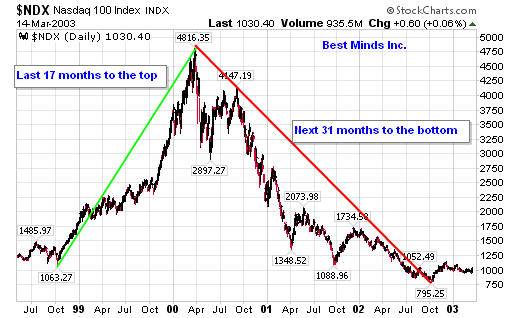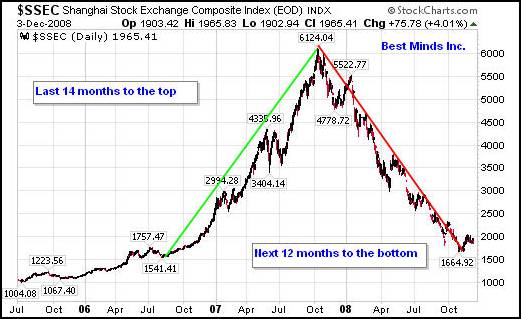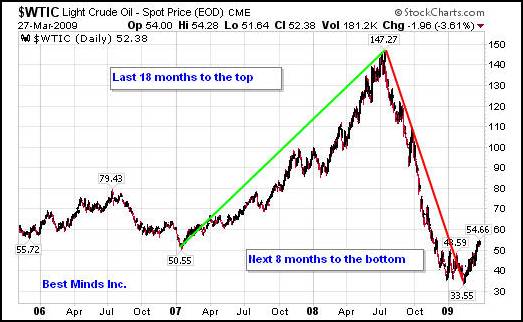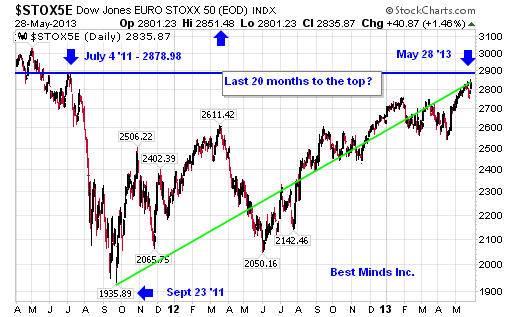Not So Sweet Sixteen May 28, 2013
Doug Wakefield
“In
the spring of 1720, Isaac Newton stated, “I can calculate the motions of the
heavenly bodies, but not the madness of people.” On April 20, accordingly, he
sold out his shares in the South Sea Company at a solid 100 percent profit of ₤7,000.
Unhappily, a further impulse later seized him, an infection from the mania
gripping the world that spring and summer. He reentered the market at the top
for a larger amount and ended up losing ₤20,000. In the irrational habit
of so many of us who experience disaster, he put it out of his mind and never,
for the rest of his life, could he bear to hear the name South Sea.” [Manias,
Panics, and Crashes: A History of Financial Crises, Fourth Edition
(2000), Charles P. Kindleberger, pg 31]
When
we read the story above, do we think of bubbles we have lived through in the
last 15 years? Have investors and advisors come to accept the fact that these
bubbles have ended badly, and are always looking for the END of the most recent
bubble?
Does
the acceleration of prices bring out more comments of “get out”, or “we have
much higher to go”? Does the topic of risk become front and center the higher
prices leap, or do our senses get dulled by the idea that “ ‘they’ have saved us from a serious
decline repeatedly since 2009”?
The
month of May 2013 is almost over. In the last few weeks, and especially the
last 6 months, we have watched world markets produce numbers that resemble a
gamblers addiction to hitting a lucky streak. With every “ALL TIME HIGH”, less
fear and more complacency seems to set in. Since we have been groomed to forget
the pain, and focus on the gain, “ALL TIME HIGH” has been used like a drug to
convince us that only fools don’t want a part of these easy winnings. I mean, with the state guaranteeing to do
whatever it takes to keep the party going, what could go wrong?
Yet,
ALL investors, traders, managers, and advisors have lived through recent
periods of massive losses. We do not have to return to the 1700s to find
examples of how speculating on “unlimited” higher prices have ended.



Now
I ask you, what political or financial leader cannot understand that problems
come from wild periods of short-term price speculation? Is there not a major
financial network that cannot see the value of producing educational charts
like these for their viewers? Would it not be of value for those training for
professional advisory designations like the CFP and CFA to examine the history
behind these bubbles and their subsequent collapse, thus warning their clients
as risk rises along with price?
Clearly,
the world of buy and hold did not work in these major bubbles.
It
has been almost 20 months since US equity markets bottomed in October
2011. At the time, frightening
headlines like these appeared frequently in our daily news:
BBC Does It Again: “In the Absence of a Credible Plan We Will Have a Global Financial Meltdown In Two or Three Weeks” – IMF Advisor, Zero Hedge, Oct 6, 2011
G20 Tells Eurozone to Fix Debt Crisis in Eight Days, China Daily, Oct 16, 2011
Europe has Six Weeks to Find Debt Crisis Solution, Warns Chancellor George Osborne, The Telegraph, Sept 23, 2011
Today, everyone knows that prices have change enormously since October 2011. Based on this fact, and the charts above, would we not expect that NOW would be a good time for our illustrious leaders, the financial industry, the mainstream financial media, etc, etc, to be issuing warnings about the increasing likelihood of another bubble or series of bubbles bursting in the global financial markets?
Bank of Japan Unleashes World’s Biggest Burst of Stimulus in $1.4 Trillion Shock Therapy, Financial Post, April 4, 2013
Fed Chairman Ben Bernanke: Stimulus Programme not Creating ‘Bubbles’, The Guardian, May 22, 2013
And yet, to be fair to central bankers, there does seem to be some concern from those watching for signs of a bubble due to their “monetary easing” actions (otherwise known as debts pouring into the system from the global banks as the majority of speculators seek to leverage up on the belief that more high prices are in store, or at least a quick sell when the turn comes).
IMF Says Monetary Easing Could Drive Asset Bubble, Yahoo Finance, May 10, 2013
If you will return to the chart above of the NASDAQ 100, the Shanghai Stock Exchange Composite, and the West Texas Intermediate Crude, you will notice that the final run to the top lasted approximately a year and a half. Using a highly affordable charting service (less that what millions spend on their cell phones and cable), anyone could have been watching the creation of bubbles for months. Maybe central bankers should have spent a pittance of the trillions they have created since 2009 on a basic charting service?



Can We
Just Cross One More Thousand Marker
The last 8 years of writing The Investor’s Mind has convinced me of how extremely hard it is to convince others that they are accepting deception. I say deception, because there has to be an element of accepting the deception in order to deny that we keep repeating the same mistakes over and over again. In order for us to believe that our world will never change, we must accept the lie that “if we can only reach the next thousand marker”, somehow, that is a sign of even higher and higher prices. Yet, how many are accepting the other side of this story; higher prices lead to higher debt levels by which to speculate on higher prices.
If this sounds too dramatic - which frankly, I have found that anyone reading my writings has long ago accepted the fact that we were watching a constant creation of the next financial bubble for the public’s deception of “recovery” – then consider the following thousand level markets this May.
· The Russell 2,000 (RUT) broke above 1,000 on May 20th, two days later hitting 1,008. Today, May 28th, is only the 4th day on record above this level.
· The Australian Composite (AORD) crossed 5,000 – a level it barely crossed before falling back through it in 2010 and 2011 – on April 23rd. 22 trading days later it broke back under this level.
· The French CAC 40 (CAC) crossed 4,000 on May 17th. Its highest level since 2008 was 4169 in February 2011, and the last time it closed above 4,000 before May 17, 2013 was May 31, 2011.
· The Dow (DJIA) crossed 15,000 on May 3rd, the 14,000 level being broken only 63 trading days earlier. As I write this article, the Dow’s 15,542 on May 22, 2013 is its highest price on record.
· The Nikkei (NIKK) crossed 14,000 on May 3rd, and 12 trading days came within inches of the 16,000 level (15,942) on May 23rd, before swinging down almost 2,000 points to bounce at 13,981 the next day, May 24th.
In 2000, I had bought into the idea that we were living through a paradigm shift, caused by the Internet and explosion of new technologies. By 2004, after attending one of the Ludwig Von Mises Institute’s summer workshops, and cleaning the cobwebs of my own delusion that “debt does not matter”, I began reading more and more history and trading commentary.
It is now 2013, and I am still amazed at what I can only call fear of being awaken. Through the use of powerful high frequency trading and short squeezes, direct manipulation of currencies, the soothing public rhetoric that you don’t need to worry about this “complex financial world” since central bankers are on watch, and the public’s almost subconscious belief that real world risk can be removed as long as you are not trading markets, and choose to ignore negative real world events, … we have created the perfect “surprise” bursting of various global bubbles.
Will 16,000 on the Nikkei and Dow be reached? Is that really something any INVESTOR (not speculator/day trader/ high frequency trader) should even be focused on as a sign of their prosperity? Even if these levels are reached, hasn’t the acceleration of world markets toward the next, “1000 marker” in May, and the 20 months since the October 2011 bottom already set up global equity markets for the bursting of the wildest speculative bubble we have seen yet?
Only time, and less and less of it seems to be required, will tell.
But one thing is for certain. If we don’t understand that when the short-term loans for speculation are called once again that the borrower will be slave to the demands of the lender, we have refused to learn lessons that span three millennium, not just three hundred years.
“The rich rules over the poor, and the borrower is the lenders slave”, Proverbs 22: 7
The Gods of the Marketplace, Zero Hedge, 5/25/13
“Investors borrowed $384.4
billion in April, a 1.3% gain from the previous month and a 29% rise from the
same month last year. This is an all-time record for margin debt and it
exceeds the previous high mark set in June 2007….
…The Great Depression was caused, in large part, by massive leverage utilized in the equity markets…” [bold, the authors]
If you are ready to awaken
from the “trust the state, they will save us” theme, come join us. I have and
continue to look for some of the best thinkers around in this extremely
deceptive game in order to keep my own sanity and yours.
If you are challenging your own thinking, and are seeking ideas that are outside those presented by our illustrious central planners, then I would encourage you to subscribe to my most comprehensive research and trading commentary with a 6 month subscription to The Investor's Mind: Anticipating Trends through the Lens of History. Using the logical side of our brains, rather than enjoying the emotional comfort of unlimited mania, has never been more crucial in our markets.
Specific individual and institutional consulting is also available. If you are interested in learning more, send a personal note in an email to info@bestmindsinc.com and place “After 14” in the subject box. Emails with attachments and links will be deleted.
Seven years after its
release, I still refer back to my research paper Riders
on the Storm: Short Selling in Contrary Winds (Jan ’06). I would
encourage you to click
here to download it for free.
Doug Wakefield
President
HUBest Minds Inc.UH, a Registered Investment Advisor
2548 Lillian Miller
Parkway
Suite 110
Denton, Texas 76210
Phone - (940) 591 - 3000
Alt - (800) 488 - 2084
Fax - (940) 591 –3006
Best Minds, Inc is a registered investment advisor that looks to
the best minds in the world of finance and economics to seek a direction for
our clients. To be a true advocate to our clients, we have found it necessary
to go well beyond the norms in financial planning today. We are avid readers.
In our study of the markets, we research general history, financial and
economic history, fundamental and technical analysis, and mass and individual
psychology.